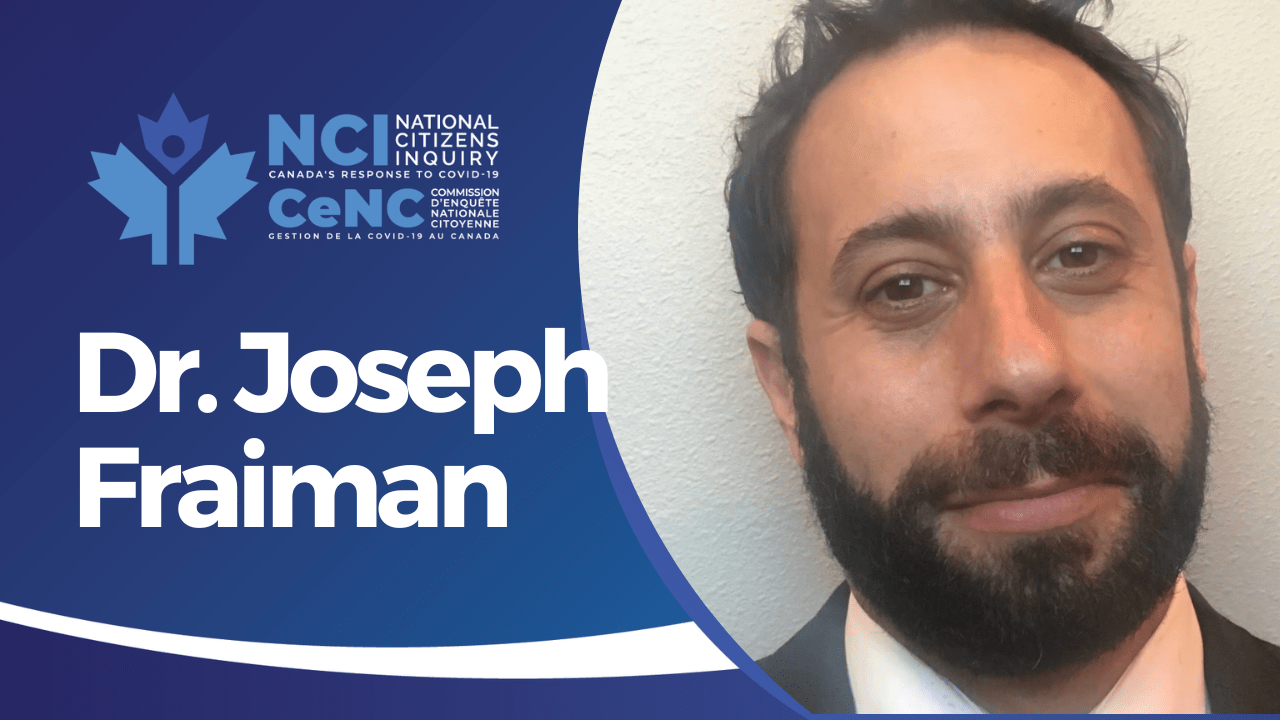Dr. Fraiman shows the inconsistency of reporting and how many vaccinated people were not documented as such in the early stages of the vaccine rollout – this significantly effecting the statistical data collected. Evidence provided that up to 90% of the COVID cases in the LA hospitals by 2022 were not admitted due to COVID and were simply incidental.
View / Listen: Rumble|Apple Podcasts|Spotify|Google Podcasts|Podbean
[00:00:00]
Chad Horton
Just one moment, Dr. Fraiman. Yes, he has been affirmed. Would you like us to start over? No?
Dr. Fraiman, we had a technical difficulty a moment ago, so we’re now streaming. Can you please, for the benefit of the Commission and for our audience, provide us with a brief overview of your education, training, and experience?
Dr. Joseph Fraiman
My name is Dr. Joseph Fraiman. I am an emergency physician today and my medical licensing began with medical school at Cornell Medical College. I did my residency at Charity Hospital in New Orleans, Louisiana. I still work in the Louisiana region. I’m a former medical manager of the Louisiana Urban Search and Rescue Disaster Task Force. And I’m also a clinical scientist specialized in analyzing medical interventions for harm and harm benefit analysis.
Chad Horton
Can you just expand on that a little bit, Dr. Fraiman, where you say that you’re a clinical scientist who specializes in harm-benefit analysis. What is the background associated with that area of specialty?
Dr. Joseph Fraiman
That’s the area of research that I’ve been involved in since residency. I’m here today, basically, as I’m the lead author of what’s become a paper with a large impact that reanalyzed the messenger RNA COVID-19 vaccines’ serious adverse events.
Chad Horton
Can you tell us, Dr. Fraiman, when that paper was published and who, if there are any, the co-authors might be?
Dr. Joseph Fraiman
Yes, there are six. We’re an international team. Some are from Spain, Australia, California. We have some in Baltimore. One of the authors is a BMJ editor. Another author is one of the top epidemiologists in the world. He has written a book on epidemiology. Another is a former NIH [National Institutes of Health] associate director of clinical research.
Chad Horton
Okay. And I understand, Dr. Fraiman, that you prepared a presentation [Exhibit TR-0011] to assist in your examination today. And if you have that ready to go, I would invite you to begin.
Dr. Joseph Fraiman
I do, but I need to be given a screen share option. I can start without it, as we figure out the technical here.
Chad Horton
One moment.
Dr. Joseph Fraiman
In the Emergency Department, I believe it’s important just to understand the experience that I’m given and what I’ve been witnessing through the COVID-19 pandemic. Where I work is a rural Louisiana hospital in Cajun area, which I understand is the long-lost cousins of the Acadians up north and from your region. And it’s my pleasure to have worked with them. I drive an hour and a half to work out in that region, because I really enjoy being the doctor of these patients.
March 2020, Louisiana was hit really bad with the first COVID surge, and we saw a large number of hospitalizations and death. Working in the emergency room during this period was a horrifying experience for myself and my nurses. Typically, when someone inside the hospital gets ill, there’s an emergency. At nighttime, I’m the only physician in the hospital, and I am called up to the room with something called a rapid response. It’s an automated electronic voice that comes over the loudspeaker and we have to go and resuscitate them. This happens normally once, maybe every three shifts
[00:05:00]
that I would experience that in normal times. During COVID-19, during the first surge, we were going to these two or three times every shift. It was quite exhausting to see, emotionally, the amount of death that was occurring during this time.
But I want to point out during this time, when I was going to work, I would look at the news and see, “Oh, hospitalizations, they’re rising.” And then I would come into work and they were rising. Deaths rising. Same for cases. And then they were decreasing again. Then for the second surge, it was a very similar experience in the Emergency Department. But these metrics that we were using to count hospitalizations, I can’t say that they were accurate because I don’t know that. But I do know that, when they said they were rising, they were rising. And when they were falling, they were falling. It was almost like looking at the weather on your phone before you go outside, and it feels exactly like the weather that you just looked at on your phone. And that’s the anecdotal experience that I feel like is important to understand. Because we see so many patients, when you see these patterns, they should fit exactly what we’re being told is happening. Because we see enough patients that the anecdotal experience should match it.
Chad Horton
I’ll tell you, Dr. Fraiman, you can screen-share now if you like. Just to contextualize some of your commentary a moment ago, you referenced the first surge and the second surge. Can you tell us when those times were? I understand your evidence is that you did see an increase in hospitalizations and deaths during what you characterized as the first surge and the second surge. When were those surges?
Dr. Joseph Fraiman
Yes. The first surge was March 2020. The second was in the summer, and then the third was in the winter.
Chad Horton
All of 2020? Yes, okay. Continue sir.
Dr. Joseph Fraiman
Of course, let me screen-share now. I’m here to talk about the COVID-19 vaccine, and let’s begin with what we see is the randomized control trials. This is the New England Journal [of Medicine]’s publication of Pfizer’s trial, and that’s what I’m going to be focusing on, but the Moderna trial is very similar. We got this. This is one of the most amazing results that I’ve ever seen, and it’s quite impressive. This is the reduction in symptomatic infections. You can see here, this blue line is the unvaccinated; and you see here, the vaccinated, they just stop getting symptomatic infections. This is an impressive finding.
But, at the time, I was actually not satisfied so much with it because I would have preferred they showed a reduction in hospitalizations, given that was, I believe, the most important concerning thing. But actually, because I’ve been researching with this vaccine and really going deep into this, I have found that in this study, there was a reduction in hospitalization in the original trials. It’s just very difficult to find, and they don’t really report on it. But if you look into this emergency use authorization, the review memorandum on page 30, and the supplementary appendix for Moderna’s New England trial, New England Journal, you can find what the hospitalizations were. And we did see it. There were not that many hospitalizations in the placebo group, but there were zero hospitalizations in the vaccine group, and we got a hospital reduction of 2.3 for 10,000.
We’re seeing what we want to see. The vaccine is reducing hospitalizations in the clinical trial.
Chad Horton
Dr. Fraiman, can you just get a little closer to your microphone or just project your voice a little bit more?
Dr. Joseph Fraiman
Yes, can you hear me better now?
Chad Horton
One moment, yeah. Go ahead, sir.
Dr. Joseph Fraiman
Okay, so here we have it for Moderna. More people were infected in the placebo group. Again, no one was hospitalized when these vaccines went for authorization.
Chad Horton
Okay, so just to help everybody understand: the slide that you just showed us, the two previous slides, where it says “vaccine zero,” that means that zero of the vaccinated group were hospitalized. And then I believe for Moderna, it was nine in the placebo group and that would mean that nine people who received placebo, the fake vaccine, did go to the hospital.
Dr. Joseph Fraiman
Yes. That’s exactly what I’m saying.
Chad Horton
Okay.
[00:10:00]
Dr. Joseph Fraiman
For death reduction, there were not enough deaths in either group to determine if it was reducing COVID-19 vaccine from COVID-19 deaths. And here you can see this is their table. It’s about equal. But then we moved into what would be called the observational data, after it was authorized. Then again, we’re seeing impressive numbers here for hospitalizations and death. Ninety-five per cent reductions essentially, all around the board. This was a pretty well-cited study.
But I also put this study up here to bring up another point, because this observational study also was heavily critiqued. Because when you do an observational study, you try to get rid of all the confounders, which are the things that are associated with the vaccine, like for example, people being older who got it. If you just compared that, you would end up with the wrong answer. So you need to control for all the different things. And for this study, they did try to do that, but they missed something. And that was the number of tests that were done. It turns out that 18 per cent of the tests were done in the vaccinated and 82 per cent were in the unvaccinated. That imbalances the groups. Now, I’m not trying to say that that means that the vaccine doesn’t work, just that that changes exactly what we’re doing. And if you adjusted for that, it would show the vaccine efficacy somewhere in the 75 to 80 per cent range. Which is still great. We’re still getting what we want to see.
But the point of this is that, generally, with observational data, after we try to attempt to identify all the things that we could adjust for, for confounding, they tend to overestimate benefits a bit. And that’s just something to think about when we start looking as the trial data—as the observational data—moves through time. So here, I just wanted to talk about what happened in the ER after the vaccine came out.
Chad Horton
Just a moment, Dr. Fraiman. When you say what happened in the ER, are you going to be speaking about your own direct observational experience?
Dr. Joseph Fraiman
Yes, my own experience. And what we saw in my hospitals was basically: after January 2021, we went months without seeing a vaccinated person have an infection or be hospitalized. It was looking very good.
I remember actually when the first vaccinated breakthrough infection occurred. And it was in April of 2021, and the whole hospital— We were all shocked to see it, the first one.
Then we all know kind of, the effects waned. Then we started the boosters. What I want to point out also is: during this time—I’m a witness in multiple hospitals—it became a little difficult to say how exactly how well the vaccine was reducing hospitalizations. There was some mis-categorization in what I was seeing, in that if a patient received a vaccine outside of the hospital system, there was a good probability they weren’t recorded as vaccinated. You could have a vaccinated person in the hospital that is being thought of as unvaccinated in the global, national way we’re counting vaccinated versus unvaccinated. It was systematically biased in that you would never have an unvaccinated person hospitalized be called a vaccinated person. The only way the mis-categorization would happen was in one direction. I don’t believe this was purposeful. I just think that this was a systematic problem. And this has been reported in in many countries that this problem occurred.
Chad Horton
Just a moment, Dr. Fraiman. Just so I can understand. You’re saying that the only way, within the system that you worked in, that somebody may be recorded as being vaccinated is if they in fact received their vaccination in the hospital, and then it would have been documented as such. Is that correct?
Dr. Joseph Fraiman
That’s not the only way. It also could be entered manually.
Chad Horton
Okay.
Dr. Joseph Fraiman
In one hospital, for a while it was difficult to enter it manually. We didn’t know how to enter it manually for several months, but eventually we learned how to enter it. But the problem is, if you are relying on this manual entering of it, then you’re going to still end up with a systematic problem unless you’re operating at perfection.
Chad Horton
Okay let me ask the question a different way, Dr. Fraiman. What sort of vaccinations may have been occurring that would not find their way into the system and database?
Dr. Joseph Fraiman
Ones that were performed in tents, where they’re giving out COVID vaccines.
[00:15:00]
In New Orleans, they were giving them out in bars. There was a campaign of shots for shots and they’re giving out shots to get people to take the vaccines. And these didn’t necessarily get into the system very quickly. There wasn’t a way to put them in.
Chad Horton
Okay, so as a result of these non-recorded vaccinations, you would have patients going into the hospital and being admitted, and they would be recorded as not having been vaccinated because they may have been vaccinated in a way that wasn’t recorded, correct?
Dr. Joseph Fraiman
Yeah. That’s exactly what I’m saying. I also want to be clear: I’m not saying that this shows that the vaccines weren’t working or anything like that. I’m trying to point out that we’re losing some of the reliability of the metrics of hospitalization and vaccine status.
Chad Horton
Now, to the extent that you can comment on this: What sort of proportions, if you have any awareness of this, might we be talking about between appropriately-recorded vaccine recipients versus individuals who receive the vaccine in a manner that would not have been cataloged?
Dr. Joseph Fraiman
I don’t know. I’ve seen many examples of it, but it wouldn’t be possible for me to give a realistic answer.
Chad Horton
Would a significant number of the population have been receiving the vaccine outside of the hospital setting, where it wouldn’t have been recorded?
Dr. Joseph Fraiman
The majority.
Chad Horton
Continue.
Dr. Joseph Fraiman
Let me pull my screen-share here up a moment. Now that’s our observational stuff here through the early days. And I want to return us back to the clinical trials to look at harm. This is what we did with the study that I was referring to before. Here are my esteemed colleagues who I worked on this with, and what we did is we looked at serious adverse events.
The term “serious adverse events” was defined the same by both Pfizer and Moderna: it was death; life-threatening hospitalization; disability; or a physician considered it serious for some other reason. That’s what the large paragraph down there is. What I want to be clear is, the term “serious,” the definition is true to its nature. All of these would be a serious outcome.
To analyze this for Pfizer, for example, we had to go through the FDA [Food and Drug Administration] briefing. Also, we used the Canadian one at some point to double-check that everything was the case. This is what a table looks like here. There’s no information you glean from that, but I just want to show you this. It’s a list of each individual serious adverse event. Here is acute myocardial infarction, and the number of times it happened in each group.
Chad Horton
What is acute myocardial infarction for the layperson?
Dr. Joseph Fraiman
That’s a heart attack.
Chad Horton
Okay.
Dr. Joseph Fraiman
There’s all different types of disorders here. And we went through this whole table that goes down for pages. We simply added them up for each group: the vaccinated and the placebo.
Chad Horton
Okay, this slide here. I want to ask you a question about this, Dr. Fraiman. Here, it says any event 103 at the top. We have 103 total events. Now you were just speaking about acute myocardial infarction, and there were three. So as a layperson looking at this, am I correct in understanding that we have three acute myocardial infarctions out of 103 total events? And one event of cardiac failure, congestive one, et cetera? They all fall within the purview of those 103 events.
Dr. Joseph Fraiman
I’ll explain that 103: “any event” is the number of participants who experienced an adverse event.
Chad Horton
Okay.
Dr. Joseph Fraiman
And that’s actually where I’ll be going right now. Because if you add the number of serious adverse events—what we did here—and we found this. Where I want to focus is, we’re going to look at the Pfizer data here. And what we see is— Actually, I want to go back here, because this is what you were talking about: we found 127 instead of 103, and 93 from the placebo. And what this difference looks like is there’s an additional 18 events per 10,000 participants in the vaccine group. And here, right here, this is called a confidence interval. That means there’s a 95 per cent certainty that it’s happening in between—
[00:20:00]
That if we did the study again, 1.2 to 34.9 events would occur per 10,000. And what that 95 per cent certainty gives us is what people would refer to as statistical significance.
Chad Horton
Okay, just a moment Dr. Fraiman. In the study, we have 18 adverse events per 10,000 vaccinations is that correct?
Dr. Joseph Fraiman
Additional events.
Chad Horton
Okay, and when you say confidence interval, you’re saying if we did that study again, that number 18 would fall with 95 per cent certainty between 1.2 and 34.9, is that correct?
Dr. Joseph Fraiman
Yes.
Chad Horton
Okay.
Dr. Joseph Fraiman
Which means that if we did the study again, we could be 95 per cent certain that we’d find an increase in serious harm. And now this risk ratio here is 36 per cent. That is a 36 per cent higher risk of serious adverse event. And that rate, the 18 per 10,000, is one in 555. So one serious event happened for every 555 people in this trial. That is quite a high number for serious adverse events from a vaccine. Typically, we have withdrawn vaccines for one in 10,000.
Chad Horton
Okay, Dr. Fraiman. Again, as a layperson: Is it one serious adverse event for 555 people vaccinated or 555 shots received?
Dr. Joseph Fraiman
People in the vaccine group.
Chad Horton
Okay.
Dr. Joseph Fraiman
It’s not per shot.
Chad Horton
Thank you.
Dr. Joseph Fraiman
People have asked us: When we did this study, what type of serious harms are we talking about? That’s quite a difficult question. Let me show you one way that we try to look at this. There’s something called these Adverse Events of Special Interest, which is a list created by this group, the Brighton Collaboration, endorsed by the WHO.
Chad Horton
And the WHO is the World Health Organization.
Dr. Joseph Fraiman
Yes, the World Health Organization.
Chad Horton
Okay, continue.
Dr. Joseph Fraiman
They figure out what are the adverse events that are likely to be caused by the vaccine so that we know what to look for when we’re studying it. And we took this list of these adverse events that are likely to be caused by to pay attention to, and we chose just those. This is what it ends up looking like. It’s a little confusing here, but I just wanted to show you the whole thing. I’m going to pull this together to explain it. What we see here, this is the Pfizer trial, and the differences in events per 10,000. What you see is a lot of small numbers per 10,000, but they’re all—almost all—positive. There’s only one, two negatives, a handful of zeros. Out of 15, ten are positive.
Chad Horton
What does positive and negative mean in this context?
Dr. Joseph Fraiman
Thank you. Negative would mean that they happened less in the vaccine group. For example, here they have acute liver injury that happened slightly less in the vaccine group. And we expect this to jump around all over the place, but we should expect the negatives to be about comparable to the positives. Here we’re seeing lots of small differences, all like about one in about 10,000.
Except for, here is a little higher. That’s the coagulation disorder, which was higher in both Pfizer and the highest one in both Pfizer and Moderna. These include blood clotting, diseases of blood clotting, and diseases of bleeding. The reason I pulled this all together here is to show why the serious adverse events are increasing. It’s not one type of harm, it’s increasing in multiple different places, but very small amounts, about one in 10,000. But when you take one in 10,000, 10 times, that becomes one in a thousand.
What we’re seeing here is lots of these small harms, but we are not certain exactly which ones—just that the coagulation disorders are coming up a little bit more. But we don’t have power from the studies: There’s not enough people, there’s not enough events. But when you add them up, you can see the difference between the groups. And here we did this for both Pfizer and Moderna, and we combined them. And again, we could see when they’re combined, the adverse events of special interest for Pfizer and Moderna are increased.
[00:25:00]
And here we’re seeing this 12.5 in 10,000 increase, or 43 per cent increase.
Chad Horton
Can you go back? Can you go back to that slide for a moment? So it says mRNA vaccines and serious AESIs. What is an AESI?
Dr. Joseph Fraiman
Sorry, that’s the adverse event of special interest. The ones that the Brighton Collaboration said created a list of the potential serious harms that we needed to basically pay attention to and potentially could be related to the vaccine.
Chad Horton
Okay, what this says, Table 2, serious adverse events, how I read this is: between the clinical data from Pfizer and Moderna, you are seeing 12.5 serious AESIs per 10,000 participants, is that correct?
Dr. Joseph Fraiman
That is correct. And that’s about 1 in 800. I think we’re looking at the numbers that are probably within that range. The 1 in 555 we saw: it justifies their serious adverse events. Here we’re seeing 1 in 800, we’re in the same range. But I think the important thing here is not just to focus on the harms. You have to put them together. And so ideally, we would have an all-cause hospitalization chart. But, as I said before, the hospitalization data wasn’t really part of their study. You had to look really hard to find it, and this simply wasn’t part of the study at all. It wasn’t reported. It’s a little unusual, but—
Chad Horton
What is all-cause hospitalization and why is it important?
Dr. Joseph Fraiman
That means if you were you hospitalized for any reason. If you’re looking at a COVID-19 hospitalization, or what about a person who had a heart attack and had COVID-19. You’re not certain even if it was COVID-19 that caused it, or if the vaccine caused a heart attack. What you want to see with all-cause hospitalization is that the vaccine reduces all-cause hospitalization. Because, on the other hand, if you increase it, that means serious harms are causing hospitalizations. If you decrease all-cause hospitalization, it means the vaccine is reducing hospitalizations enough to give you that benefit that’s outweighing the serious harm that it’s causing.
Chad Horton
Understood.
Dr. Joseph Fraiman
Now, since that wasn’t there, we use the method that essentially creates something like that, in a way. We wanted to compare these serious adverse events of special interest with hospitalization reduction. Earlier, I showed you the hospitalization reduction was there for Pfizer. It was around 2 in 10,000. And this is what we’re seeing from the clinical trials, is that there were about 10 serious adverse events of special interest per 10,000, and hospitalization reduction was 2.3 for Pfizer, and 15 versus 6.4 for Moderna.
I know that this looks bad and scary. I don’t want people to walk away from this saying that our study proves the vaccine is causing more harm than benefit. That’s not what it’s doing.
I think it’s important to put this into context. And for that, it’s to understand the limitations of what this analysis gives you, and how to interpret it. When we published this study, we received a large number of critiques. We were fact-checked by multiple fact-checking organizations, and they mainly got their sources from scientists, bloggers, and YouTube videos. These critiques, while they would say that they were debunking our article, that’s not actually the case. They were offering critique. That’s what we call that in science, a critique, which raised limitations. And we appreciated their critiques, and we incorporated them when we published initially as a preprint, and then later as a peer-reviewed publication. We incorporated these limitations, and we thought it helped us understand how to interpret this data. I think to go through them will be valuable here for you.
For example, one thing that they had said was that it’s not possible to do a proper harm-benefit analysis with only two months of data post-vaccine. I and the co-authors completely agree with that. But there’s nothing that we could have done to avoid it. That’s just the data that existed from the clinical trial.
[00:30:00]
The larger question is, if it’s not proper to do a harm-benefit analysis with only two months of data, then why did our governments decide to authorize a vaccine without the ability to do a proper harm-benefit analysis? And why is it two months not enough time? The point they were raising is that if the trial went longer, there would have been more infections. If the trial went longer, there would have been maybe a surge of COVID-19, and this would have led to more hospitalizations. They also said: if the people were sicker, if they were older, there would have been more hospitalizations.
This is all true, and it brings to the point that the hospitalization rate of their population is a big part of hospitalization reductions: the vaccine efficacy and the hospitalization rate. You need both. Now, on that limitation they point out, though: It also goes the other direction. If you have a population that’s been mostly infected, as much of our population has, you get less hospitalizations. If you have variants such as Omicron, which cause less hospitalizations, or a variant like Omicron that has reduced vaccine efficacy because of an immune escape, the virus now knows how to get around the vaccine better than the prior strains.
That is a problem, but it shows what I’m trying to say here. It shows the fragility of that harm-benefit analysis. It can swing towards harm or benefit depending on the situation, on the hospitalization rate or the vaccine efficacy, which are changing through time. And with Omicron, we’re going to return back and see what I witnessed in the emergency room.
Chad Horton
And when was the time frame of Omicron? Can you remind us just so we can contextualize what you’re about to say?
Dr. Joseph Fraiman
It’s about 2022, or late December 2021 is when it started. I would say about February is when it became 100 per cent the dominant strain in the United States.
Chad Horton
Okay.
Dr. Joseph Fraiman
When this occurred, we started seeing something that was a bit problematic for hospitalizations. Well, not problematic: it was great in the sense that we weren’t really seeing many at all. And the last hospitalization that I’ve seen for COVID-19 that was a clear symptomatic case was in February of 2022. Over a year ago.
Chad Horton
Wait, just a moment. Dr. Fraiman, are you saying in your capacity as a physician, the last time you saw a COVID hospitalization was February of 2022?
Dr. Joseph Fraiman
Yes, for the one that was a clear syndrome of COVID-19. There could have been a patient who had a heart attack. Was that caused by COVID? I don’t know. But it didn’t look like the COVID-19 from the prior, where they had this classical syndrome where they would become very short of breath. And that’s the reason we were taking them into the hospital generally.
So it could be that someone was an asthmatic, and they’re having an asthma attack and they have COVID-19. It would be difficult to distinguish between the COVID-19 and the asthma attack. But what’s important to understand here is, I admitted a lot of people to the hospital this year who had COVID-19. But this is incidental, most of it. And some of it could be relevant. It’s difficult to tease it out. I know that this sounds crazy to some people, but all my nurses would tell you the same thing. I’ve asked ER doctor friends—maybe a handful of people have admitted one or two or three that are clear cases. I want to pull up this video here. Let me share my screen here with you. Can you see the video?
Chad Horton
Yes, sir.
Dr. Joseph Fraiman
Okay, this is the CMO of Los Angeles County Hospital talking about Omicron infections [no exhibit number specified]. I believe this was in July, August:
[Video clip of Dr. Spellberg, CMO of Los Angeles County Hospital]
It’s like two months of the same. You can see LAC numbers on the graph. It’s just plateaued and it’s not going down. It’s sort of a trickle up a little bit, not much. It’s just been like that. We’re getting thousands of cases going across the county. The numbers of LAC COVID positive tests have continued to go up. But this isn’t because we’re seeing a ton of people with symptomatic disease getting admitted. On the bottom graph it’s the same thing. We’re seeing a lot of people with mild disease and urgent care needs. You could go home and do not get it.
[00:35:00]
All those who are admitted, 90 per cent of the time, are not admitted due to COVID.
Chad Horton
Okay, Dr. Fraiman. No, our audio was not great, so just a couple of things. Who was the individual who was speaking?
Dr. Joseph Fraiman
His name is Dr. Spellberg. He’s the Chief Medical Officer of L.A. County Hospital.
Chad Horton
Okay, and I’d just like you to summarize for the Commission and for the audience what that gentleman said, because our audio was quite muffled.
Dr. Joseph Fraiman
I’m sorry for that. Now, what he’s saying here, using this graph, is that during Omicron, 90 per cent of his COVID admissions were not due to COVID-19. Ninety per cent of them in his hospital: they were incidental. And he’s not alone.
Chad Horton
Okay, Dr. Fraiman, when you say incidental, am I correct in understanding that they’ve gone to the hospital for some other reason, but they just happen to be COVID positive? Is that what you mean by incidental?
Dr. Joseph Fraiman
Yes, I’ll give you an example. A person who’s missed dialysis. They come in and they need to get emergency dialysis. We test every single person who gets admitted to the hospital and a lot of them started coming back positive. Then you go back and ask the person, “Hey, do you have a cough or anything like that?” They would answer, “Now that you say it, I do have a little sore throat.” That’s what we were seeing. It’s incidental, it’s unrelated to their hospital admission.
For incidental hospitalizations, in Denmark, they did a great job trying to figure out how many there were. It’s difficult to figure it out but their estimate was about 75 per cent. So 25 per cent to 35 per cent are actual COVID-19 in their estimates. This other hospital said 90 per cent of people who are admitted right now with COVID-19 are not actually in there for COVID-19. Now this is a disaster for our metric. The best metric to measure this vaccine’s efficacy is we need to know hospitalization rates and mortality rates. With a metric where 75 per cent to 90 per cent of them are incidental, it makes it incredibly unreliable.
The other thing that I wanted to point out is that I have also seen people with prior infections become infected again. I don’t have a memory of a prior infection being hospitalized, but it’s quite rare in general. Here we have a meta-analysis looking at this. There is about 90 per cent protection against hospitalization during Omicron. That’s 40 weeks after infection, that’s how far these studies went. The point is: it’s highly protective for a very long time and nearly our entire population has been infected at this point.
Hospitalizations during Omicron are important because we need to know the hospitalization rate, because that affects that harm-benefit analysis that we were talking about.
There’s a study out of Southern California Kaiser system. Of 4.7 million people there were 200,000 or so infections. They said, “After infection, what’s your likelihood of being hospitalized?” And they looked at Delta versus Omicron. Here’s your likelihood with Delta and here’s your likelihood with Omicron.
Chad Horton
All right, you’re talking about likelihoods and cumulative probability percentage on the vertical axis. Does this mean 0.5 per cent of what, or 1 per cent of what?
Dr. Joseph Fraiman
People who were tested positive.
Chad Horton
Okay so 0.5 to 2 people who tested positive for COVID-19 would be admitted to the hospital, is that correct?
Dr. Joseph Fraiman
Yes.
Chad Horton
Okay, and days on the horizontal axis is how many days post what?
Dr. Joseph Fraiman
I believe it’s infection.
Chad Horton
Okay.
Dr. Joseph Fraiman
It’s a Kaplan-Meier curve, so each time that there is an infection, it makes it jump up.
Chad Horton
Okay, and what is the difference between the red line and the blue line?
Dr. Joseph Fraiman
The red line is Delta. The blue line is Omicron. So the hospitalization rate is much lower. Also keep in mind that 75 to 90 per cent of those are incidental, okay? Then when we look at the serious outcomes: ICU mechanical ventilation, mortality approaching zero, it’s difficult to distinguish the two.
Now, everyone should sit back and look at this and, actually, you can smile. This is actually really great news.
[00:40:00]
But our mortality rate is difficult to discern from Omicron today.
Chad Horton
It is difficult to discern mortality from Omicron, because why?
Dr. Joseph Fraiman
I’m saying it’s so low. It’s close to zero. People were infected with Covid 19. This is the percentage of the Omicron people who die after infection. It’s very low. It’s lower than Delta, much lower. It’s— This is about 0.07. I think this was 0.01. I could be wrong on that, but I believe it was about a seven-fold decrease in death with Omicron in this study. And we also must look at vaccine efficacy to figure this out.
Here’s one study from The Lancet. They’re showing vaccine efficacy against Omicron now is around 30 per cent. I want to show just the CDC, because I think that they’re considered a reliable source on this. They’re saying that, at first, we’re getting about 60 per cent efficacy. Over 120 days we’re seeing around 29 per cent. We need to be aware of this big issue here. Twenty-nine per cent: when you get to that low of an efficacy it just becomes pretty unreliable. Remember, when I looked at the 95 per cent efficacy and I said that you if you miss one of these confounders—and you likely will—it will change results. But, if you have 95 per cent, it’s okay if you drop to 75 to 80 per cent. We’re still seeing a pretty large benefit. Here, if you drop, you can hit zero easily.
We’re trying to figure this out in the setting of these massive number of incidental hospitalizations. We’re really driving blind here, and we do not know at all how effective these vaccines are anymore. All we do know is that, from what we were dealing with before, when they were tested, we know that the hospitalization rates are lower. We know that we can’t rely on it particularly well. But we do know that it’s lower and we know that the vaccine efficacy is lower. When you have that level of uncertainty, and when we looked at that harm-benefit analysis and how fragile it is, that creates some serious problems. We need to take this seriously that we saw serious harm increases. It appears that they’re happening in both trials. We’re flying blind and the differences between the harms and the benefits are small. This is going to be impossible to figure out with observational data moving forward. We have no chance of doing this. I believe we will remain in uncertainty.
I want to point out that people are claiming certainty: that they know the vaccine benefits are outweighing the harm. I don’t see how that’s possible. I don’t know what metric they’re using to measure. I just pointed out: you can’t even rely on the hospitalization data. But we can figure this out. It’s not hopeless. There’s really one way to figure this out. We have the tool, and we need a double-blind randomized trial to figure this out.
Chad Horton
What is a double-blind randomized clinical trial, for those of us with no medical training or who are not research scientists?
Dr. Joseph Fraiman
This is when we randomize people to two different groups. Remember the confounding that I was talking about? The problem with observational data is because different people end up in different groups for various reasons. Here, you randomize them so that you get rid of those differences. When there’s any difference between the group, you know that the cause of it is the intervention. To use all-cause hospitalization: that would ensure, that would make this whole process easier, so I don’t have to talk for one hour explaining how we get this. We could just see the vaccines reducing all-cause hospitalizations. That means it’s doing better than if it wasn’t there. Doing this currently with observational data on hospitalizations with unreliable metrics: like I said, we’re driving blind, and we could potentially be causing harm. We could potentially be doing benefit. I don’t know the answer, I’m uncertain. But I know how to get the answer, and this is how we would obtain the answer.
[00:45:00]
Until then, I would have trouble recommending the vaccine, when I don’t have a level of certainty that I could promise to get the benefit. That’s what I really wanted to get through here today.
Chad Horton
Before I turn you over to the panel for questioning, I have a couple of points of clarification for myself, Dr. Fraiman. I would ask you to go back to the two slides that show instances of harm versus benefit. And there were two slides in succession.
Dr. Joseph Fraiman
Okay, I know, from our study.
Chad Horton
Yes. Thank you. I just want to understand this correctly. So we have 10.1 adverse events of serious interest for 10,000 individuals who received the vaccine. Correct?
Dr. Joseph Fraiman
Yes. Serious adverse events.
Chad Horton
We have 2.3 individuals we believe were kept out of the hospital per 10,000 individuals who received the vaccine, correct?
Dr. Joseph Fraiman
You know, I may I have an error here. It says hospitalization reduction. It should say COVID-19 hospitalization reduction.
Chad Horton
Yeah, that’s what I understood. So is my understanding correct in that sense?
Dr. Joseph Fraiman
Yes.
Chad Horton
Okay.
Just a minute, Dr. Fraiman, I’m not finished. In the next slide, I believe, is the same analysis for Moderna, correct? Yes. Okay. And 15.1 serious adverse events risk, 15.1 events in 10,000 individuals who receive the vaccination versus—we believe—6.4 individuals per 10,000 vaccine recipients were kept out of the hospital due to COVID-19.
But what I’m understanding you saying is that these are the ratios that you were able to extract from the clinical data, but the clinical data is only based on two months of information. Correct?
Dr. Joseph Fraiman
Yes. We authorized the vaccines quickly because we saw the benefit. They were authorized and the blinding was taken away and they gave the vaccine to the placebo group. We have a very short amount of data that’s reliable.
Chad Horton
I’m going to ask you if you can comment on this or explain this to myself or the Commission or the audience. When I hear that the clinical trial was two months, and this is the result of that clinical trial, where does the determination that these products were safe and effective come from?
Dr. Joseph Fraiman
I don’t know the origin of the term safe and effective, but it’s not a term that I would use to describe a medication.
Chad Horton
Would that be considered a scientific assessment?
Dr. Joseph Fraiman
I don’t think it is. “Safe” implies that there’s no risk. Safe means that there’s no chance of harm. It doesn’t mean that harm is happening. You have to know that if something’s safe, that means you’ve studied it well and that you are certain that there is no harm from it.
Chad Horton
Okay.
Dr. Joseph Fraiman
Breathing air is safe, but driving drunk is not safe. Even if you don’t crash when you drive drunk, it’s not safe. You can die. If you drive home drunk, it doesn’t mean that what you did was safe; you must know that there is no chance of risk.
Chad Horton
Can we objectively say, based on this admittedly flawed two months of data that we have—Because you discussed some flaws in the timing and in the methodology. And if we can extrapolate: the chance that you will sustain an adverse event of significant interest is more than twice the chance that you’ve been kept out of the hospital as a result of this Moderna injection. Is that what this table is telling me?
[00:50:00]
Dr. Joseph Fraiman
That’s what it’s suggestive of, but I wouldn’t think of it in that way. Remember those confidence intervals. We have to think about this range of possibilities here and so it’s possible the harms are a little bit less, or it’s possible they’re a little bit more. This is just the two months of data. We’d have more if there were older people in the trial, or if it was running for longer, you could have had more hospital reduction. There’s some variability here. I wouldn’t conclude that our study is proof that you’re twice as likely to have a serious adverse event.
Chad Horton
Now, this data that you analyzed, was this data available to the bodies that would have been responsible for approving these vaccines?
Dr. Joseph Fraiman
The original data that I ran through with the Pfizer data, anyone could have done. We only added the serious adverse events. We found that they were higher in the Pfizer trial. Anyone could have done that at the time and shown that there was a 1 in 555 chance of a serious adverse event in the vaccine group. They did not analyze them in that way; they analyzed slightly differently a participant. The problem was, so you saw earlier, you saw there was 103 versus 83—and that ends up not being significantly different. You can see that here, 103 versus 81. It’s a 20 per cent increase.
But the problem is that if you experienced a serious adverse event, you were also twice as likely to experience multiple in the vaccine group. So it leads to just more events in the vaccine group. I think that anyone could agree that it’s worse to have two people have a serious adverse event than one person have two. At the same time, I think we can agree it’s worse for one person to have two serious adverse events than to have one. So these two metrics of measuring participants or number of events—they’re both important values to look at. And we did. The regulatory bodies, Pfizer and Moderna, they didn’t look at it. They didn’t count the number of events; they only counted the number of participants.
Chad Horton
Okay, Dr. Fraiman. I’m going to open you up to any questions that may be posed by the panel.
Commissioner Drysdale
Hi, Doctor. I’ve got a number of questions. I’m not a doctor, so forgive me if I don’t word it exactly right. The data that you presented to us, and not your analysis, but the data itself: Was that the data that the approval bodies had in order to arrive at an approval for this? Was this the study that was used by the authorities to approve the vaccines?
Dr. Joseph Fraiman
Yes. This is page 87 of the FDA briefing for Pfizer. It’s the advisory committee meeting for the FDA. It’s called the VRBPAC [Vaccine and Related Biological Products Advisory Committee]. This is in their page 87 in the FDA briefing for Pfizer.
Commissioner Drysdale
Understood. Some of the things that we’ve been hearing from some of the people who have testified over the last number of days is that they got a shot, they had a reaction the next day, they went to their doctor, reported the reaction and the doctor said, “Oh, that’s not in the list, that’s not associated with it.” And my question to you is, since this is a new vaccine altogether and we don’t know what the risks really were, how would that doctor in my example make a decision that it was or wasn’t caused by the vaccine? And more importantly, when I look at the list in the raw data and it lists what they felt the adverse reactions were, is that a parsed list?
[00:55:00]
And I’m not saying it was parsed for a nefarious reason. Did someone make a decision that something happened to someone but that’s not because of the vaccine, and move on?
Dr. Joseph Fraiman
In that list, if you had an event, they were blinded in the study. So if someone came into the hospital with a heart attack, you would get listed in there—no matter if they thought it was from the vaccine or not. That’s the advantage of the double-blind trial. What you’re talking about, if the doctor is not thinking that it’s from the vaccine, they’re still supposed to report that to our system.
Commissioner Drysdale
Right. And if this is a double-blind trial, if someone went into the hospital with a heart attack, did they count it as an adverse reaction? Or did they say, “We don’t think that was an adverse reaction,” so they left it off? Do you know what I’m trying to say?
Dr. Joseph Fraiman
It would be on the list. If they had any serious event, it should be on their serious adverse event list. If it’s happening in the placebo group or in the vaccine group, it should be in both.
Commissioner Drysdale
Okay, I understand. And also, the slides went by a little quickly for me but we talk about adverse reactions and we talk about reduction in hospitalization. But for me, if an adverse reaction could be death, I would want that parsed out separately. Certainly, it might have reduced my hospitalization, but I’d like to know what my comparison of death as an adverse reaction versus death from being in the hospital was.
Dr. Joseph Fraiman
I agree. The problem is that we didn’t have the data to do that from the clinical trial. There was no difference between deaths in the groups. So yes, that would be ideal if we had a mortality benefit, or just an all-cause mortality. Are you more likely to live or die with this vaccine? That would obviously be excellent, to have that information. But we didn’t have that in the clinical trial, so we couldn’t study that.
Commissioner Drysdale
Circling back to where we started: we’ve got data that we don’t quite understand how we would make a safety recommendation on, with all this missing data. Safety isn’t just that a group of events happen, but the severity within the group of events. I’m an engineer, and if I were designing a building, an event might be cracked drywall. But another event might be the floor collapsed. What’s the result of grouping this all together and not understanding the severity risk or the severity of a failure? It seems to me that there was no way they could assess that.
Dr. Joseph Fraiman
They can in some ways, but some ways not. The serious adverse event definition is designed to kind of do that. That would be the floor collapsing. I’m sure there’s multiple other serious things that can go wrong with the building. If it got the label of serious, it was considered serious by death, hospitalization, or permanent disability. In that is a wide variation of things. One of them could be a stroke and the other one could be a bad case of diarrhea that needed to be admitted to the hospital for extra fluid. You’re still being hospitalized for it. The same is also true with COVID-19: there’s going to be a wide range of COVID-19 hospitalizations. There’ll be some mild cases that get discharged the next day; they were just admitted for observation. Then there’s some who are going to be intubated and have a breathing tube placed. Both hospitalizations and serious adverse events have a range of badness. Their minimum is somewhat comparable in that they both should be considered serious.
[01:00:00]
Commissioner Massie
Thank you very much, Dr. Fraiman. I have a couple of questions regarding the ratio you came up with. Because I noticed in one of your slides and I had read that previously in your paper: when you compare the placebo from Moderna and Pfizer, it seems that, for some reason, the placebo in Moderna is about twice as high in terms of adverse events of serious interest, special interest, compared to Pfizer. Given that the numbers we’re reporting all together are about in that range, would you have any idea why there would be such a difference in the placebo between the two different clinical trials?
Dr. Joseph Fraiman
Yes. The whole purpose, I believe, of the randomized control trial is that we randomize it so that both groups are the same. But what looks like happened in the Moderna trial is their group was a little bit sicker, a little bit older, maybe just more fragile in one way or another. So they ended up having higher hospitalization rates for COVID-19 and they had higher overall adverse events and higher hospitalization rates from COVID-19. Which is what I think you would expect with a population that’s just a little bit more sickly. The key is that they’re randomized so that both the vaccine and the placebo in any one trial are compared. You compare the same level of fragility with the ones that got the vaccine and the placebo. That’s the advantage of a randomized trial.
Commissioner Massie
Coming back to the placebo, I mean, these were double-blinded random clinical trials, right?
Dr. Joseph Fraiman
Yes.
Commissioner Massie
So I’m wondering, in terms of the placebo again: in the mRNA technology, this is an emulsion because of the lipid composition of encapsulating the mRNA, and it has an appearance of somewhat opalescence compared to, say, water or saline. I’m just wondering if they use saline in the placebo, whether the people that were actually doing the injection couldn’t be aware that in one case it was the placebo and the other case it was the vaccine? Do you have any information on that? Because I haven’t seen anything.
Dr. Joseph Fraiman
There is. I believe what you’re pointing out is, was there unblinding in the trial? And did the people who got vaccinated realize they got the vaccine and did the placebo realize they got the placebo? Is that what you’re asking?
Commissioner Massie
Yeah, I’m asking because saline is very different from the vaccine itself. If you look at the bottle, it’s pretty obvious.
Dr. Joseph Fraiman
Yes. It’s reported that people in the vaccine trial were also in Facebook groups together. They were all talking to each other. We know that, after the COVID-19 vaccine, over half of people get pretty serious, severe symptoms like fevers and headaches and they feel lousy. A lot of people can’t go to work the next day. The people who got the vaccine felt that and the people who got the placebo didn’t. And it seems like from their messages in Facebook groups that probably a lot of them did sort of know which group they were in. Which is bad.
That is a problem for unblinding, but it’s still the best that we got for understanding these vaccines. I agree that could complicate it for interpretation of the data.
Commissioner Massie
Maybe one last question to wrap it up. Given the level of data that the regulatory agency was exposed to in order to make a decision, and when you looked at the overall benefit or advantage of the vaccine and the potential for serious adverse reaction: Was there enough data to really put forward the vaccination campaign, given that we don’t know about what would happen even in six months or one year from now? Because at this point the data was two months. So if you go with the precautionary principle, with that part of the equation in terms of recommending to go ahead with vaccination, and still today, to promote the vaccination in the Omicron phase—?
[01:05:00]
Dr. Joseph Fraiman
I think that, at that time, there was a difficult decision that had to be made. The emergency use authorization was given at the time because of the seriousness of the pandemic that was going on. There were some chances that were taken by approving it early, before we had all that data, because there was a hope that it was going to save lives. I think at the time it was a difficult decision probably to make.
In 20/20 hindsight, I know for sure that I would very much have liked a better clinical trial to know what’s going on. It may have been short-sighted to get the vaccine authorized and then realize we are now stuck in this pool of uncertainty on this vaccine. There are some different ways that things could have gone. I have trouble faulting people when I think back to the emotion at that time. How desperate people felt, the fear that they were having from this disease and the possibility of the hope that this vaccine offered. I can’t give an answer if it was the right or wrong thing.
I personally wouldn’t have voted for it, at least for people under the age of 65. I would have wanted much more data on people under 65. For people over 65, I would have been hard-pressed to have voted against it. But that choice also wasn’t given in the FDA, to only give it to one group. So I think it’s a difficult question. I don’t see why we approved it in people under the age of 65, when we had the time to do further studies. And it wasn’t as much of an emergency in that group. I think that maybe we confused the public with the kind of public health messaging that maybe overestimated the risk for people in that age group.
Commissioner Massie
In the current situation with Omicron and where we are at with all the people that have been previously infected, would you recommend that the general vaccinations should be suspended?
Dr. Joseph Fraiman
I believe that we need to explain to the public where we are on our certainty level on this vaccine. Does it mean that some people could still make the decision with that uncertainty and choose to take the vaccine? That’s also difficult to say, but I don’t think that we should be recommending it widespread to everyone ages six months and up, or continuing to boost indefinitely without knowing if the harms and benefits, which one is higher. And continuing that with no end in sight doesn’t seem like a reasonable plan.
Commissioner Massie
Thank you.
Dr. Joseph Fraiman
And do you have any more questions? I can’t hear.
Chad Horton
That will be everything Dr. Fraiman, thank you.
Dr. Joseph Fraiman
Thank you very much.
[01:09:15]
Final Review and Approval: Jodi Bruhn, August 3, 2023.
The evidence offered in this transcript is a true and faithful record of witness testimony given during the National Citizens Inquiry (NCI) hearings. The transcript was prepared by members of a team of volunteers using an “intelligent verbatim” transcription method.
For further information on the transcription process, method, and team, see the NCI website: https://nationalcitizensinquiry.ca/about-these-transcripts/
Credentials
- Cornell Medical College graduate
- Charity Hospital, New Orleans, LA residency
- Emergency physician, Louisiana
- Former Medical Manager at the Louisiana Urban Search and Rescue Disaster Task Force
- Lead author of (peer reviewed) paper analyzing mRNA COVID vaccines and the serious adverse events.
- Clinical scientist specialized in analyzing medical interventions for harm and harm-benefit analysis
Summary
Dr. Fraiman shows the inconsistency of reporting and how many vaccinated people were not documented as such in the early stages of the vaccine rollout – this significantly effecting the statistical data collected. Evidence provided that up to 90% of the COVID cases in the LA hospitals by 2022 were not admitted due to COVID and were simply incidental. Studies in this same time period showed vaccine efficacy as negligible. Many studies cited and slides provided with statistics gathered. When addressing the COVID vaccines: “We’re flying blind and the difference between the harms and the benefits are small”.






















